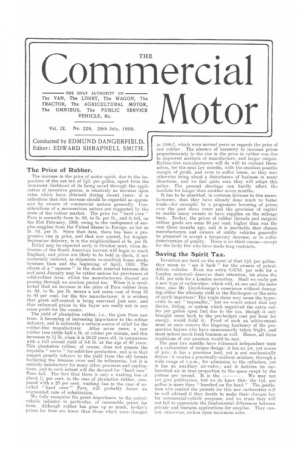The Price of Rubber.
Page 1

If you've noticed an error in this article please click here to report it so we can fix it.
The increase in the price of motor spirit, due to the imposition of the net tax of 10. per gallon, apart front the imminent likelihood of its being saved through the application of inventive genius, is relatively no increase upon rates which have obtained during recent years : it is ridiculous that this increase should be regarded as oppressive by owners of commercial motors generally. Considerations of a niore-serious nature are suggested by the state of the rubber market. The price for " hard cure " Para is normally from 4s. 6d. to 5s. per lb., and it fell, on the 21st February, 1908, owing to the reshipment of surplus supplies from the United States to Europe, as low as 2s. 9d. per lb. Since that date, there has been a progressive rise in price, and that now quoted, for AugustSeptember delivery, is in the neighbourhood of 8s. per lb.
Relief may be expected early in October next, when deliveries of the South American harvest will begin to reach England, and prices are likely to be held in check, if not materially reduced, as shipments re-establish home stocks between then and the beginning of April, 1910. The effects of a "squeeze " in the short interval between this and next January may he rather serious for purchasers of solid-rubber tires, whilst the manufacturers thereof are passing through an anxious period too. When it is recollected that an increase in the price of Para rubber from 48. 6d. to 8s. per lb. means a net extra cost of from 50 to 60 per cent, for the tire manufacturer, it is evident that great self-control is being exercised just now, and that enhanced prices to the buyer are really not in any sense profit for the vendor.
The yield of plantation rubber, i.e., the gum from new trees. is becoming of increasing importance to the rubber industry, and is indirectly a certain source of relief for the rubber-tire manufacturer. After seven years, a. new rubber tree yields half a lb. of rubber per annum, and this increases to 1 lb. when it is 10-12 years old, in comparison with a full annual yield of 5-6 lb. at. the age of 30 years. This plantation rubber, of course, does not possess the requisite "nerve " for solid-tire production, and is in that respect greatly inferior to the yield from the old forests bordering the Amazon river and its tributaries, but it is entirely satisfactory for many other processes and applications, and to such extent will the demand for "hard cure" Para fall. The fact that there is only a washing loss of about 11, per cent, in the case of plantation rubber, compared with a 20 per cent. washing loss in the case of socalled " hard cure " Para, will probably foster an augmented rate of substitution.
We fully recognize the great importance, to the petrolvehicle industry in particular, of reasonable prices for tires. Although rubber has gone up so much, to-day's prices for tires are lower than those which were charged in 1906-7, which were normal years as regards the price of raw rubber. The absence of necessity to increase prices proportionately to the. rise in the price in rubber was due to improved methods of manufacture, and larger output.. Rubber-tire manufacturers will do well to content themselves, for the next few months, with the smallest possible margin of profit, and even to suffer losses, as they may otherwise bring about a disturbance of business in many directions, and we feel quite sure they will adopt this policy. The present shortage can hardly affect the markets for longer than another seven months. It has to be admitted, in common fairness to tire manufacturers, that they have already done much to foster trade—for example, by a progressive lowering of prices over the past three years and the provision of capital to enable many owners to have supplies on the mileage basis. To-day, the prices of rubber threads and surgical rubber goods are some 80 per cent, higher than was the case three months ago, and it is inevitable that chassis manufacturers and owners of utility vehicles generally be prepared to accept a temporary increase, or to suffer deterioration of quality. There is no third course —except for the lucky few who have made long contracts.


















